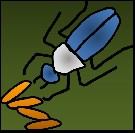Rice predators include spiders, ants, some insect families as Carabidae, plant bugs, amphibians, dragonflies, and other beetles and water bugs; however, the most important ones are the spiders—one spider can consume about 30 white leaf hoppers in a day. Spiders do not belong to the insect group but are Arachnids; that is, animals whose head and neck are not separated. One peculiarity of spiders is that they never eat rice, and only feed on insects, whereas other insect predators feed both on rice and insects.
The main spider families that can be found in African paddy fields are:
-
Lycosidae: They are often called ‘wolf’ spiders as they are often found in packs of 3 or 4 like wolves. E.g. Pardosa spp., Lycosa spp., Wadicosa spp.
-
Thomisidae: They are often called ‘crab’ spiders because they actually look like crabs and can move in all directions without turning around. E.g. Thomisus spp.
-
Tetragnatidae: They are giant spiders and their bodies are long and well developed. E.g. Tetragnata spp.
-
Araneidae or Argiopidae : They are the best weavers and really weave spider webs. E.g. Argiope spp., Gasteracantha spp.
-
Pholcidae: They are often called ‘grand-dad long-legs’ as their legs are very long and very thin. E.g. Pholicus spp.
Salticidae: They are often called ‘jumping’ spiders as they leap and jump instead of running or walking. E.g. Salticus spp.
Extract from PLAR-IRM Curriculum: Technical Manual (Wopereis et al., 2009)













